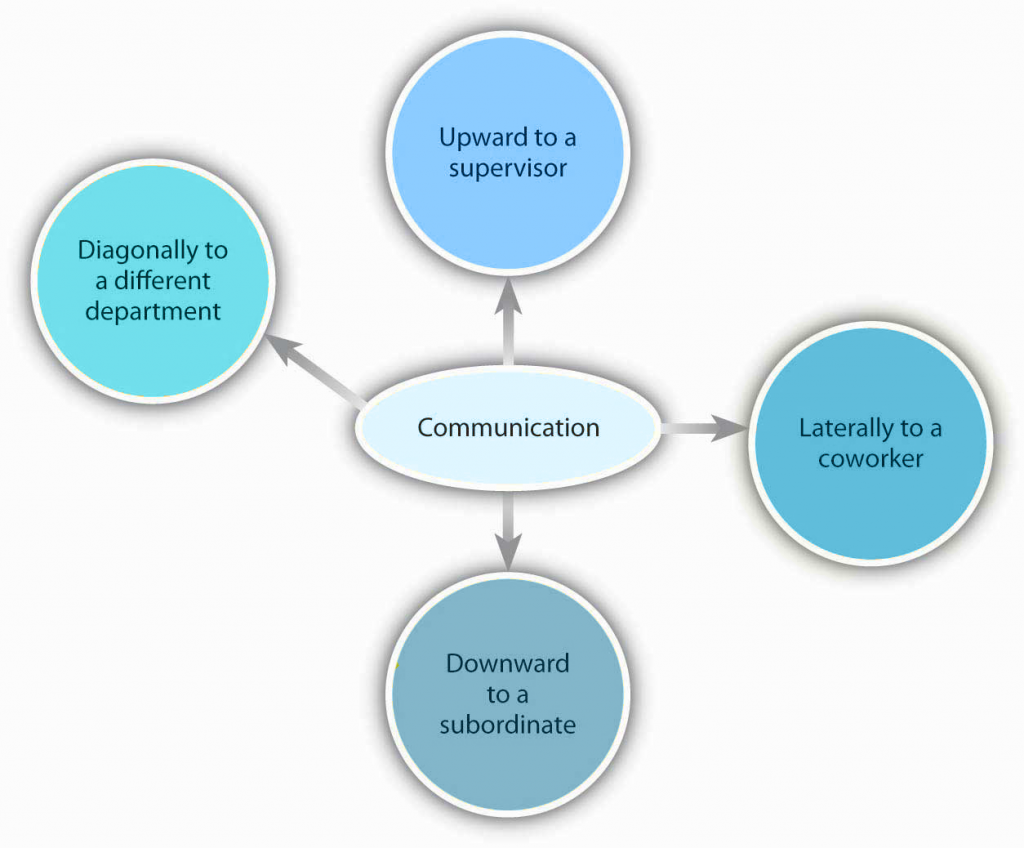2.3 Common Channels of Communication in the Workplace
Common Channels of Communication in the Workplace
The channel, or medium, used to communicate a message affects how accurately the message will be received. Verbal, written, and nonverbal communications have different strengths and weaknesses. In business, the decision to communicate verbally or in written form can be a powerful one. In addition, a smart manager is aware of the nonverbal messages conveyed by either type of communication—as noted earlier, only 7% of verbal communication comes from the words themselves.
Information Richness
Channels vary in their information richness. Information-rich channels convey more nonverbal information. As you may be able to guess from our earlier discussion of verbal and written communications, verbal communications are richer than written ones. Research shows that effective managers tend to use more information-rich communication channels than less effective managers (Allen & Griffeth, 1997; Fulk & Boyd, 1991; Yates & Orlikowski, 1992). The table below illustrates the information richness of different information channels.
Table 2.2 Guide for When to Use Written Versus Verbal Communication
| Information Channel | Information Riches |
|---|---|
| Face--to-face conversation | High |
| Videoconferencing | High |
| Telephone conversation | High |
| E-mails | Medium |
| Handheld devices | Medium |
| Blogs | Medium |
| Written letters and memos | Medium |
| Formal written documents | Low |
| Spreadsheets | Low |
Adapted from Principles of Management for Leadership Communication: Leadership Communication Edition, University of Arkansas. CC BY-NC-SA 4.0. Converted from original to a table.
Like face-to-face and telephone conversation, videoconferencing has high information richness because communicators can see or hear beyond just the words—they can see body language or hear the tone of their voice. Handheld devices, blogs, and written letters and memos offer medium-rich channels because they convey words and pictures/photos. Formal written documents, such as legal documents, and spreadsheets, such as the division’s budget, convey the least richness because the format is often rigid and standardized. As a result, nuance is lost.
When determining whether to communicate verbally or in writing, ask yourself: Do I want to convey facts or feelings? Verbal communications are a better way to convey feelings. Written communications do a better job of conveying facts.
Picture a manager making a speech to a team of 20 employees. The manager is speaking at a normal pace. The employees appear interested. But how much information is being transmitted? Not as much as the speaker believes! Humans listen much faster than they speak. The average public speaker communicates at a speed of about 125 words a minute. And that pace sounds fine to the audience. (In fact, anything faster than that probably would sound weird. To put that figure in perspective, someone having an excited conversation speaks at about 150 words a minute.) On the basis of these numbers, we could assume that the employees have more than enough time to take in each word the manager delivers. And that’s the problem. The average person in the audience can hear 400–500 words a minute (Lee & Hatesohl, 2008). The audience has more than enough time to hear. As a result, they will each be processing many thoughts of their own, on totally different subjects, while the manager is speaking. As this example demonstrates, oral communication is an inherently flawed medium for conveying specific facts. Listeners’ minds wander! It’s nothing personal—in fact, it’s totally physical. In business, once we understand this fact, we can make more intelligent communication choices based on the kind of information we want to convey.
The key to effective communication is to match the communication channel with the goal of the communication (Barry & Fulmer, 2004). For example, written media may be a better choice when the communicator wants a record of the content, has less urgency for a response, is physically separated from the receiver, doesn’t require a lot of feedback, or the message is complicated and may take some time to understand. Oral communication, however, makes more sense when conveying a sensitive or emotional message, needs feedback immediately, and does not need a permanent record of the conversation. Use the guide provided for deciding when to use written versus verbal communication.
Table 2.3 Guide for When to Use Written Versus Verbal Communication
| Use Written Communication When: | Use Verbal Communication When: |
|---|---|
| conveying facts | conveying emotion and feelings |
| the messages needs to become part of a permanent file | the message does not need to be permanent |
| there is little time urgency | there is time urgency |
| you do not need immediate feedback | you need immediate feedback |
| the ideas are complicated | the ideas are simple or can be made simple with explanations |
Adapted from Principles of Management for Leadership Communication: Leadership Communication Edition, University of Arkansas. CC BY-NC-SA 4.0. Converted from original to a table.
Business Use of E-Mail
The growth of e-mail has been spectacular, but it has also created challenges in managing information and an ever-increasing speed of doing business. Learning to be more effective in your e-mail communications is an important skill. To learn more, check out the business e-mail do’s and don’ts.
Business E-Mail Do’s and Don’ts
- DON’T send or forward chain e-mails.
- DON’T put anything in an e-mail that you don’t want the world to see.
- DON’T write a message in capital letters—this is the equivalent of SHOUTING.
- DON’T routinely “cc” everyone all the time. Reducing inbox clutter is a great way to increase communication.
- DON’T hit Send until you spell-check your e-mail.
- DO use a subject line that summarizes your message, adjusting it as the message changes over time.
- DO make your request in the first line of your e-mail. (And if that’s all you need to say, stop there!)
- DO end your e-mail with a brief sign-off such as, “Thank you,” followed by your name and contact information.
- DO think of a work e-mail as a binding communication.
- DO let others know if you’ve received an e-mail in error.
Source: Adapted from information in Leland, K., & Bailey, K. (2000). Customer service for dummies. Wiley; Information Technology Services. (1997). Top 10 email dos and top ten email don’ts. University of Illinois at Chicago Medical Center. http://www.uic.edu/hsc/uicmc/its/customers/email-tips.htm; Kawasaki, G. (2006, February 3). The effective emailer. How to Change the World. http://blog.guykawasaki.com/2006/02/the_effective_e.html.
An important, although often ignored, rule when communicating emotional information is that e-mail’s lack of richness can be your loss. As we saw in the chart above, e-mail is a medium-rich channel. It can convey facts quickly. But when it comes to emotion, e-mail’s flaws make it far less desirable a choice than oral communication—the 55% of nonverbal cues that make a conversation comprehensible to a listener are missing. E-mail readers don’t pick up on sarcasm and other tonal aspects of writing as much as the writer believes they will, researchers note in a recent study (Kruger, 2005).
The sender may believe she has included these emotional signifiers in her message. But, with words alone, those signifiers are not there. This gap between the form and content of e-mail inspired the rise of emoticons—symbols that offer clues to the emotional side of the words in each Message. Generally speaking, however, emoticons are not considered professional in business communication.
You might feel uncomfortable conveying an emotionally laden message verbally, especially when the message contains unwanted news. Sending an e-mail to your staff that there will be no bonuses this year may seem easier than breaking the bad news face-to-face, but that doesn’t mean that e-mail is an effective or appropriate way to deliver this kind of news. When the message is emotional, the sender should use verbal communication. Indeed, a good rule of thumb is that the more emotionally laden messages require more thought in the choice of channel and how they are communicated.
Direction of Communication Within Organizations
Information can move horizontally, from a Sender to a Receiver, as we’ve seen. It can also move vertically, down from top management or up from the front line. Information can also move diagonally between and among levels of an organization, such as a message from a customer service representative up to a manager in the manufacturing department, or a message from the chief financial officer sent down to all department heads.

There is a chance for these arrows to go awry, of course. As Mihaly Csikszentmihalyi (2004), author of best-selling books such as Flow, has noted, “In large organizations the dilution of information as it passes up and down the hierarchy, and horizontally across departments, can undermine the effort to focus on common goals” (p. 75). Managers need to keep this in mind when they make organization design decisions as part of the organizing function.
The organizational status of the sender can affect the receiver’s attentiveness to the message. For example, consider: a senior manager sends a memo to a production supervisor. The supervisor, who has a lower status within the organization, is likely to pay close attention to the message. The same information, conveyed in the opposite direction, however, might not get the attention it deserves. The message would be filtered by the senior manager’s perception of priorities and urgencies.
External Communications
External communications deliver specific business messages to individuals outside an organization. They may announce changes in staff or strategy, earnings, and more. The goal of an external communication is to create shared understanding. Examples of external communications include press releases, advertisements, webpages, and customer communications such as catalogs.
 Exercises
Exercises
- How could you use your knowledge of communication richness to be more effective in your own communications?
- What are the three biggest advantages and disadvantages you see regarding technology and communications?
- Explain the difference between internal and external communications in an organization, giving examples of each.
References
This section is adapted from:
Principles of Management for Leadership Communication by University of Minnesota is licensed under a Creative Commons Attribution-NonCommercial-ShareAlike 4.0 International License, except where otherwise noted.
Allen, D. G., & Griffeth, R. W. (1997). Vertical and lateral information processing. Human Relations, 50(10), 1239-1260.
Barry, B., & Fulmer, I. S. (2004). The medium and the message: The adaptive use of communication media in dyadic influence. Academy of Management Review, 29, 272–292.
Csikszentmihalyi, M. (2004). Good business: Leadership, flow, and the making of meaning. Penguin.
Fulk, J., & Boyd, B. (1991). Emerging theories of communication in organizations. Journal of Management, 17, 407–446.
Kruger, J. (2005). Egocentrism over email: Can we communicate as well as we think? Journal of Personality and Social Psychology, 89, 925–936.
Lee, D., & Hatesohl, D. (2008). Listening: Our most used communication skill. University of Missouri. Retrieved July 2, 2008, from http://extension.missouri.edu/explore/comm/cm0150.htm.
Yates, J., & Orlikowski, W. J. (1992). Genres of organizational communication: A structurational approach to studying communication and media. Academy of Management Review, 17, 299–326.

